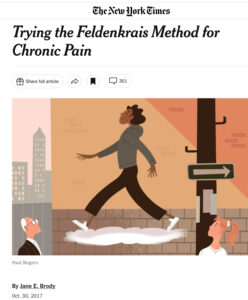What is Feldenkrais®?
Some of My Favorite References on the Feldenkrais Method
Videos
Books & Articles



Article by teacher, practitioner, and trainer Larry Golfarb describing WTF is Feldenkrais. https://mindinmotion-online.com/felden-what
Evidence
Here are a few journal articles describing some of the evidence behind the Feldenkrais Method. For a more extensive and up-to-date list, please check out: Feldenkrais Research Journal.
Feldenkrais Method for Pain, Balance, and Rehabilitation…
Study: Effects of the Feldenkrais Method as a Physiotherapy Tool: A Systematic Review and Meta-Analysis of Randomized Controlled Trials (Berland et at, 2022)
Key Finding: FM applied in ATM group sessions is effective in the treatment and prevention of some pathologies or clinical conditions. Regarding elderly people, FM improves mobility, balance and quality of life. Regarding pain, in people with chronic low back pain, FM has similar benefits such as back school lessons or core stability exercises; in people with cervical pain, the FM may be more adequate than conventional physical therapy. Regarding people with neurodegenerative diseases, the FM is effective in improving balance.
Study: The Effectiveness of the Feldenkrais Method: A Systematic Review of the Evidence (Hillier et al., 2015)
Key Finding: There is promising evidence that FM may be considered for balance classes in ageing populations, both as a preventative approach and for people at risk of falls. There is also some evidence for the use of FM where reduced effort, efficiency of movement, and awareness can play a part in reducing pain or discomfort.
Feldenkrais Method for Neurological Conditions…
Study: Use of Awareness Through Movement Improves Balance and Balance Confidence in People with Multiple Sclerosis A Randomized Controlled Study (Stephens 2001)
Key Finding: Significant improvements in balance and balance confidence in patients with multiple sclerosis after participating in Feldenkrais ATM classes.
Study: Feldenkrais method-based exercise improves quality of life in individuals with Parkinson’s disease: a controlled, randomized clinical trial (Teixeira-Machadoet al., 2015)
Key Finding: it is likely that the practice of a program based on the Feldenkrais method can contribute greatly to the QoL of patients with Parkinson’s disease.

